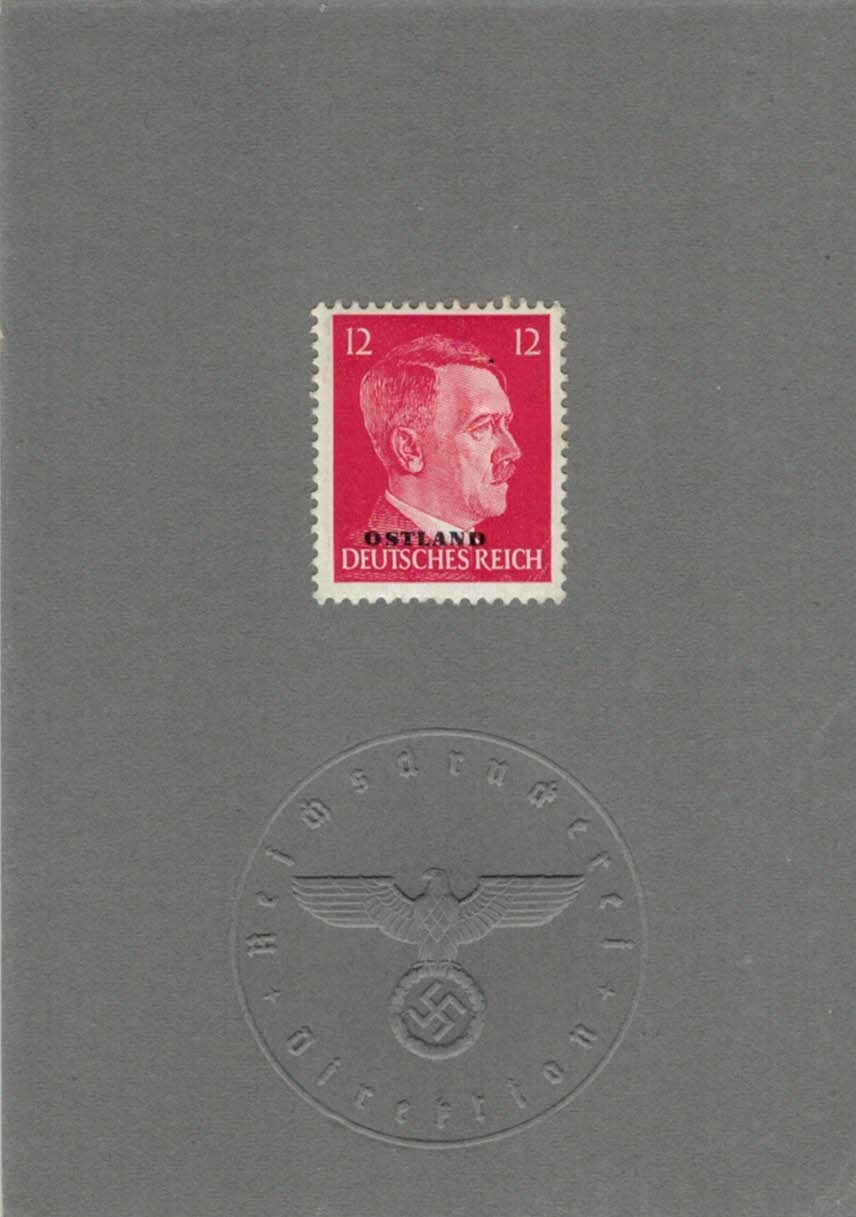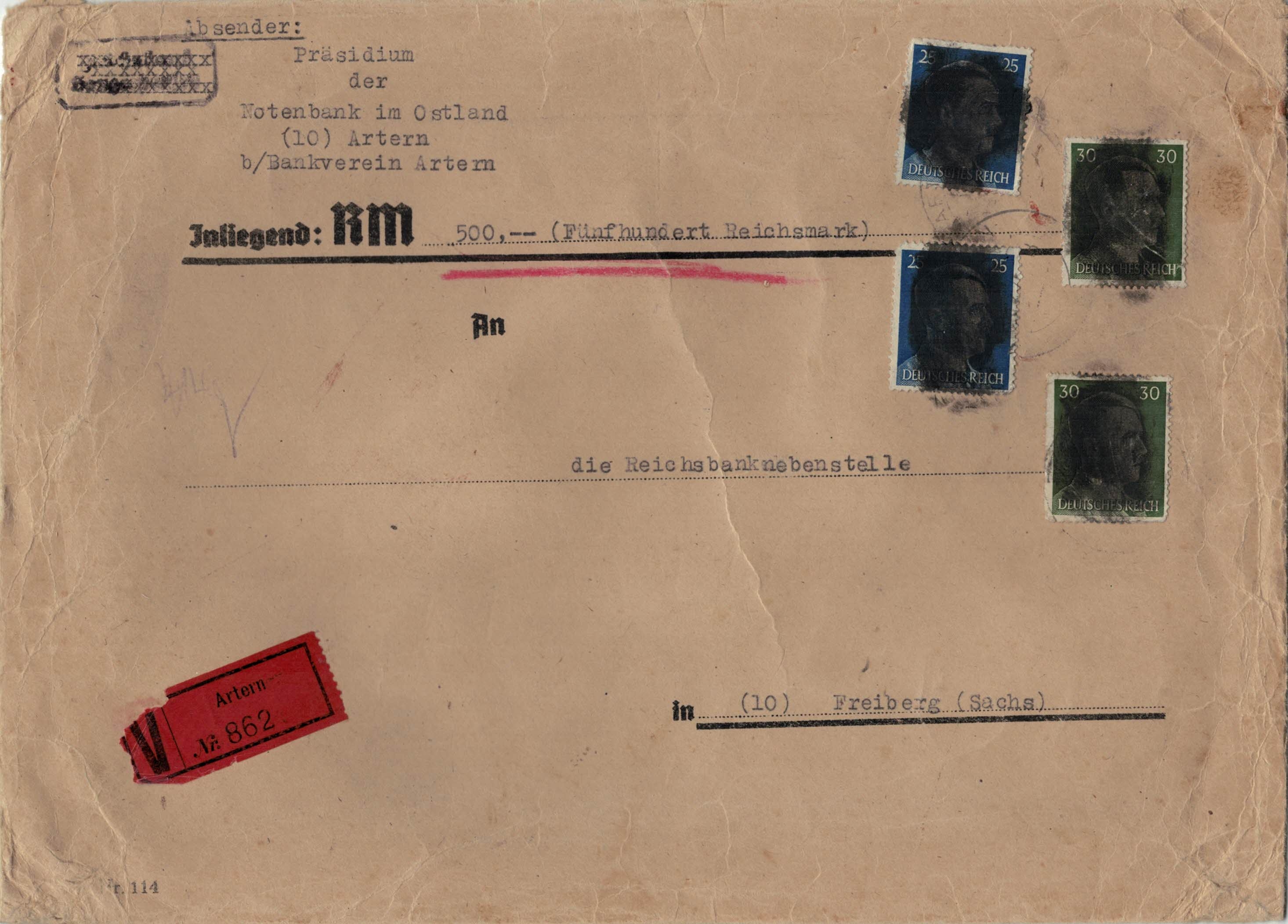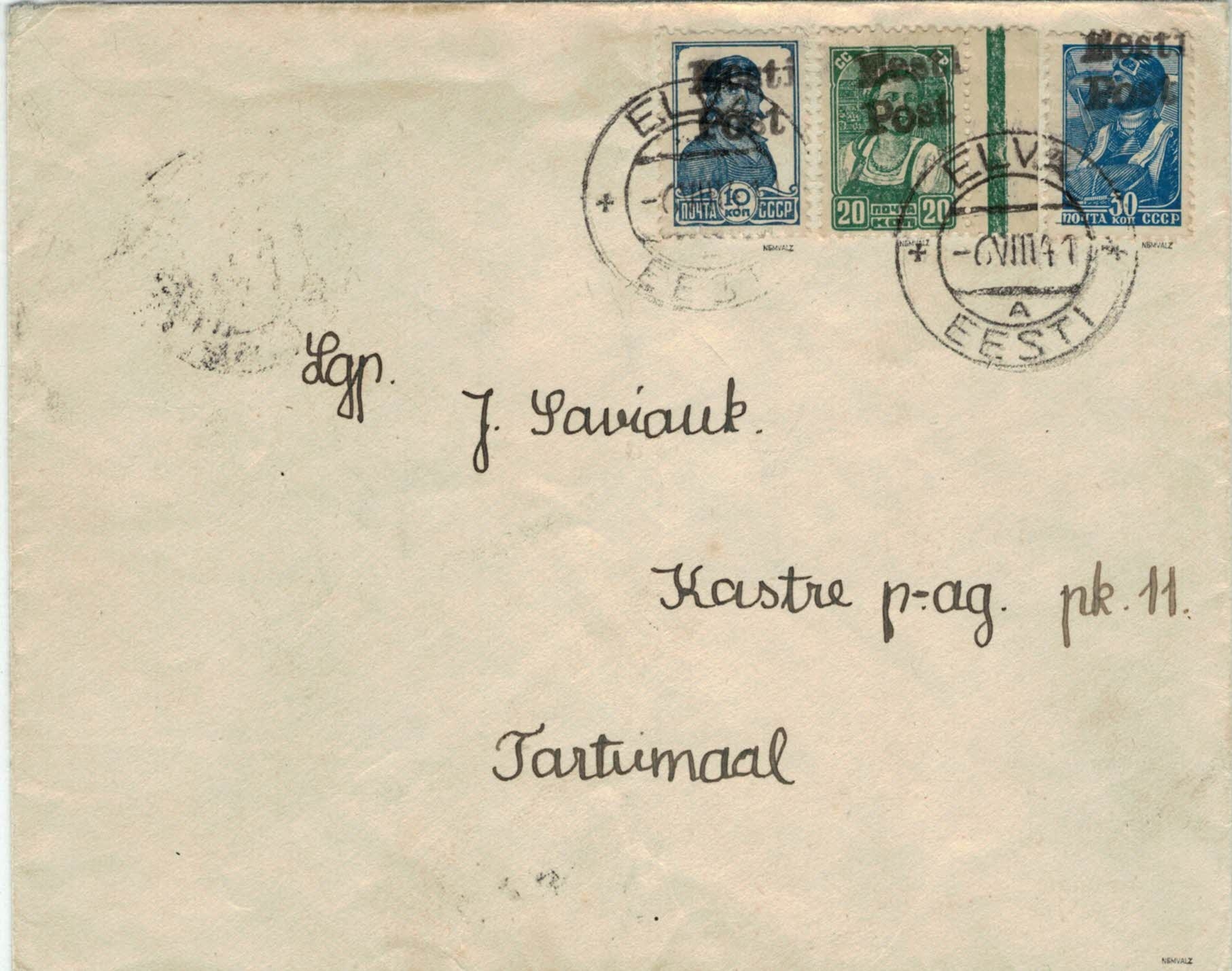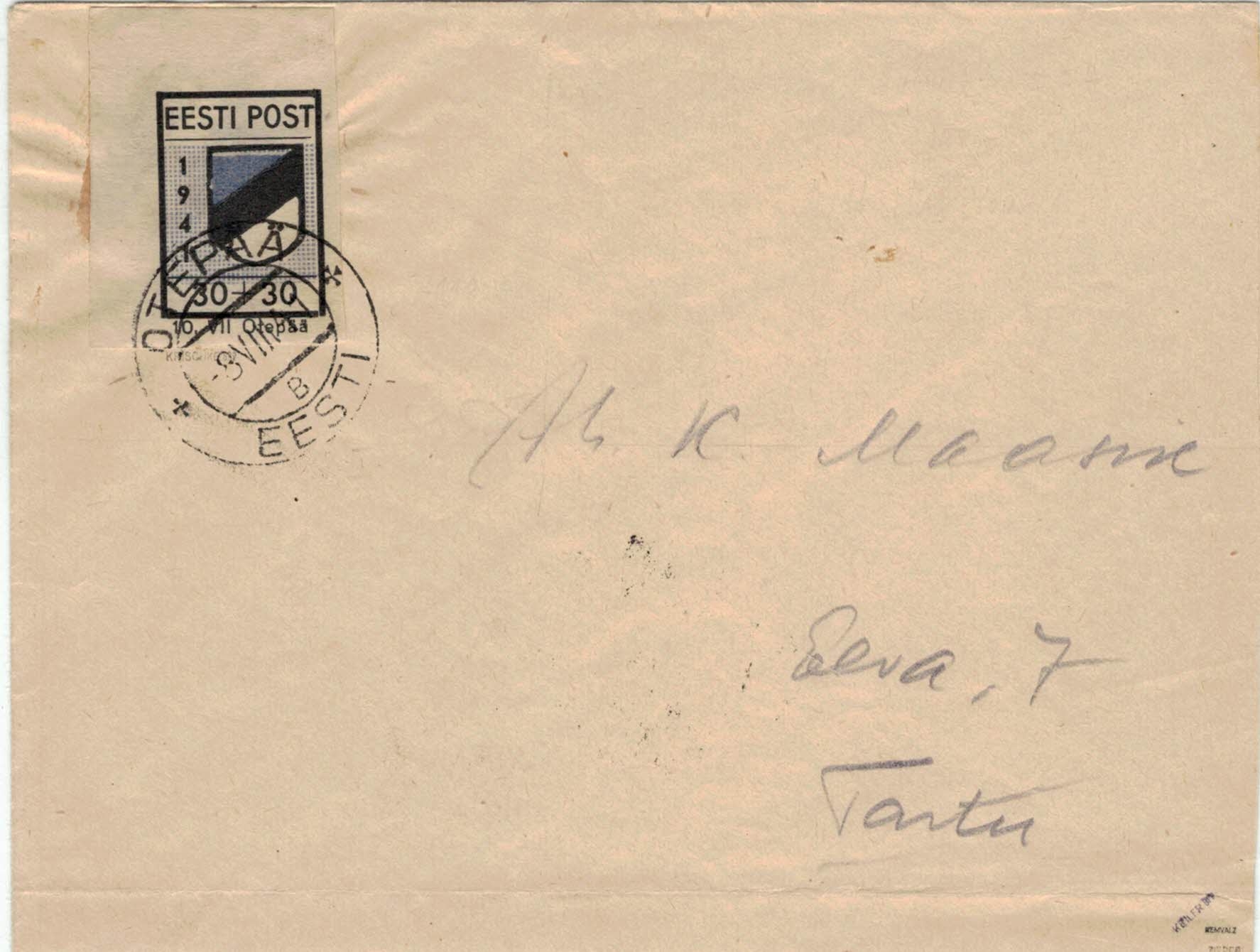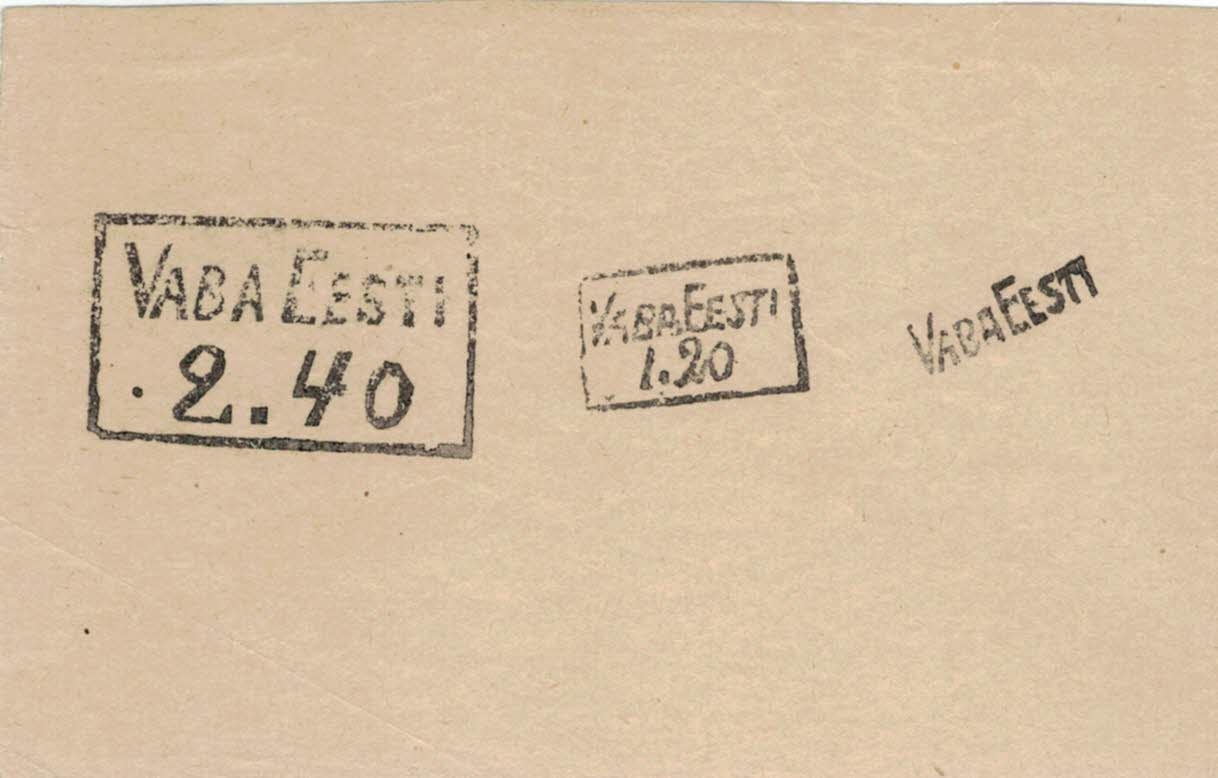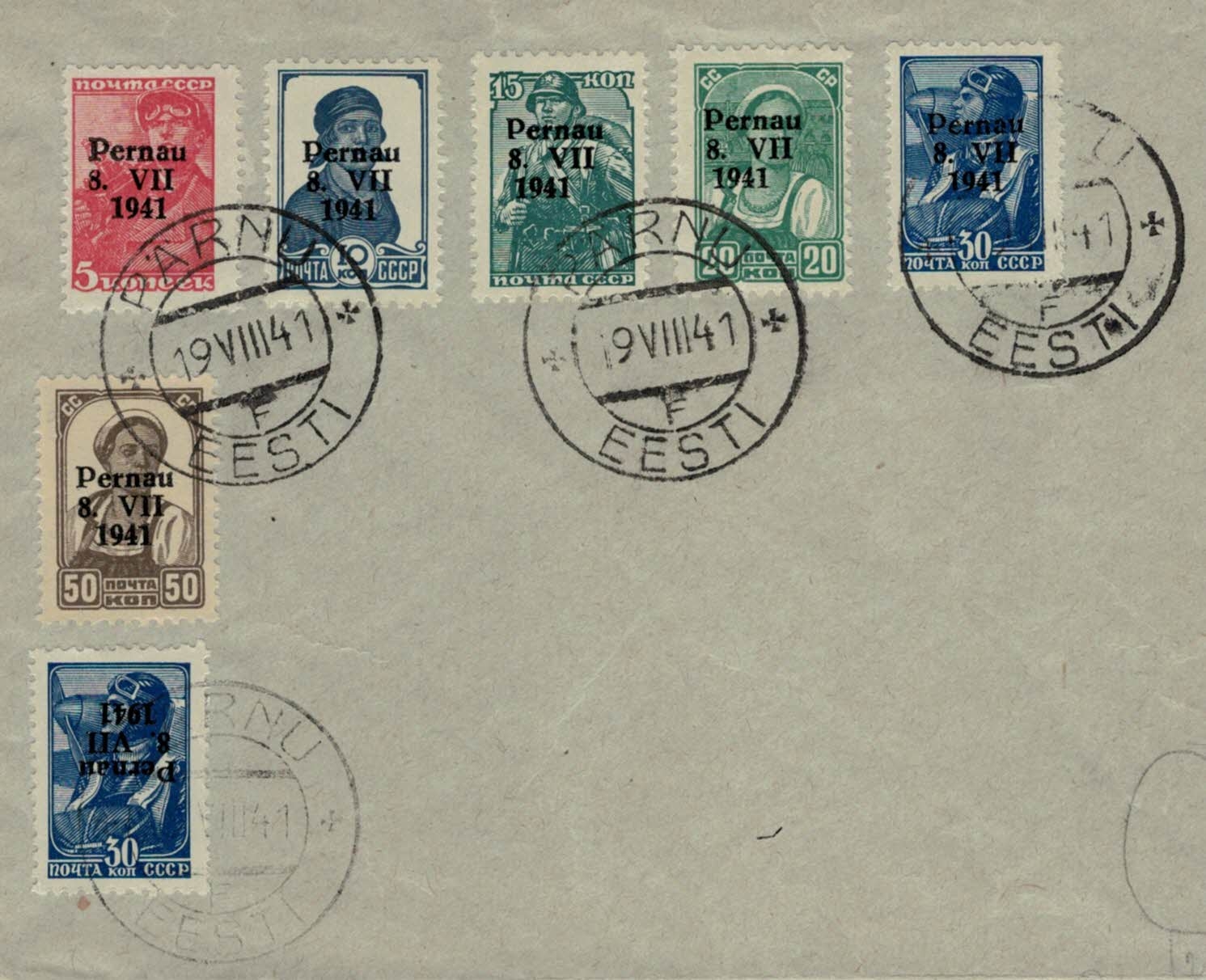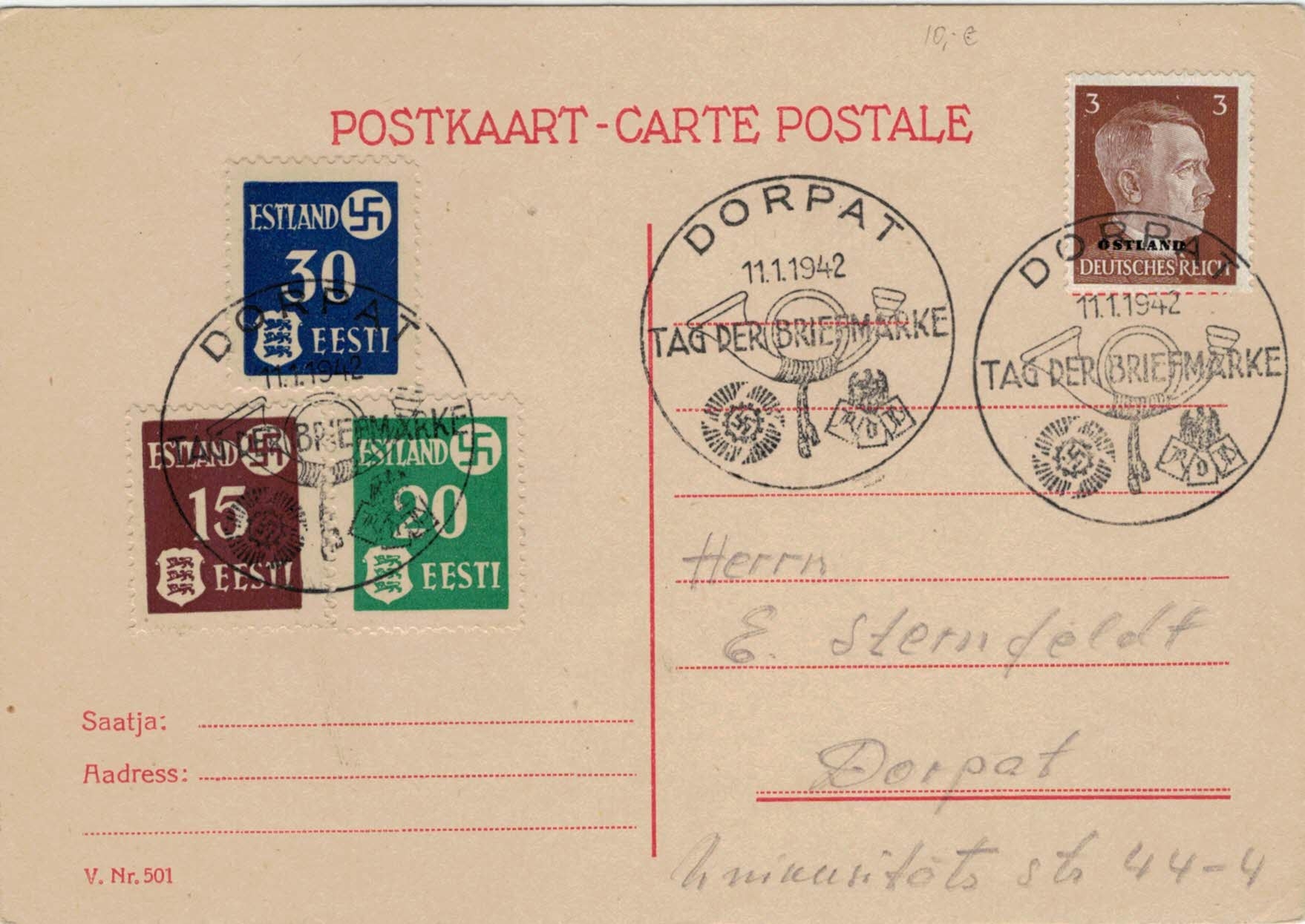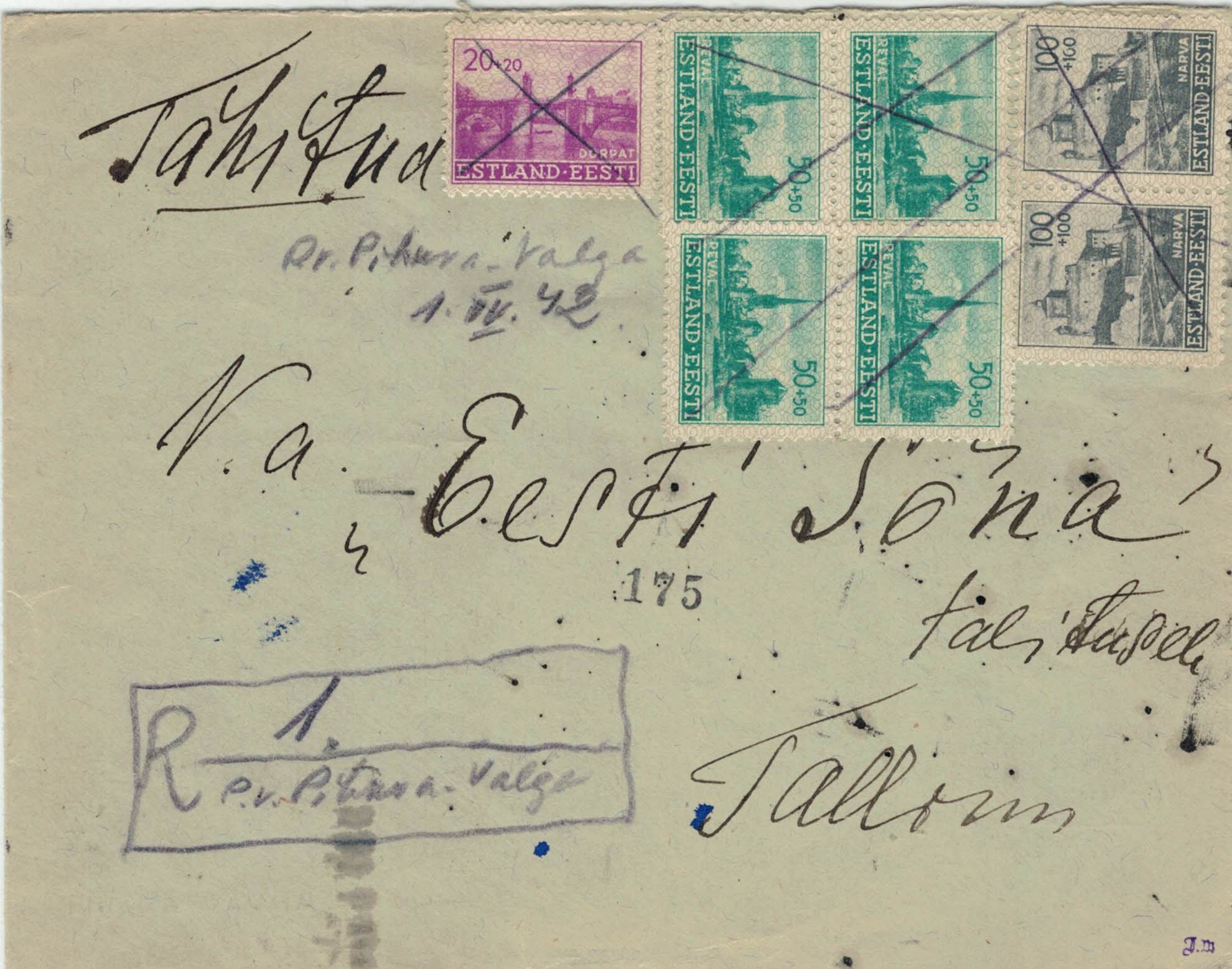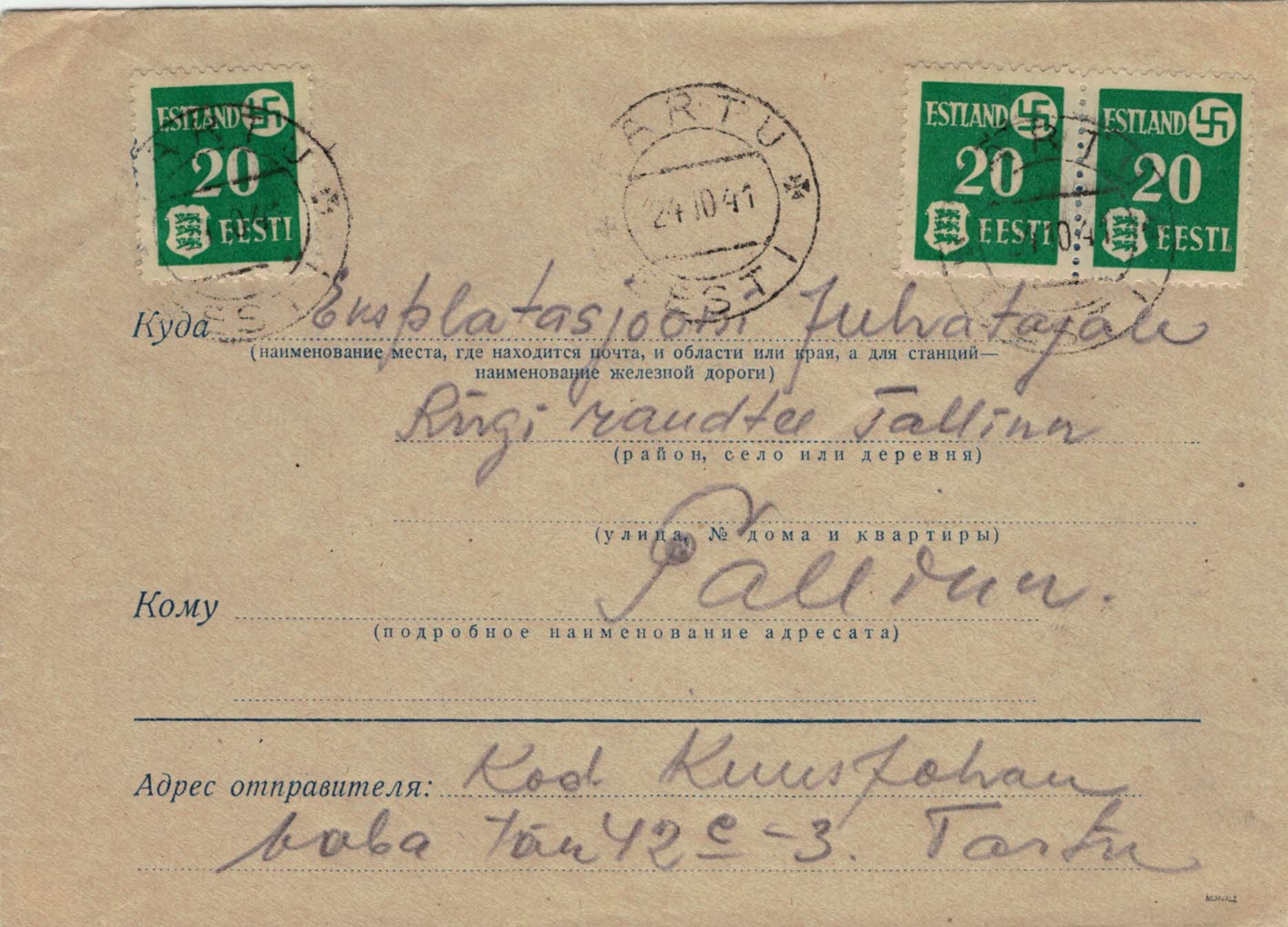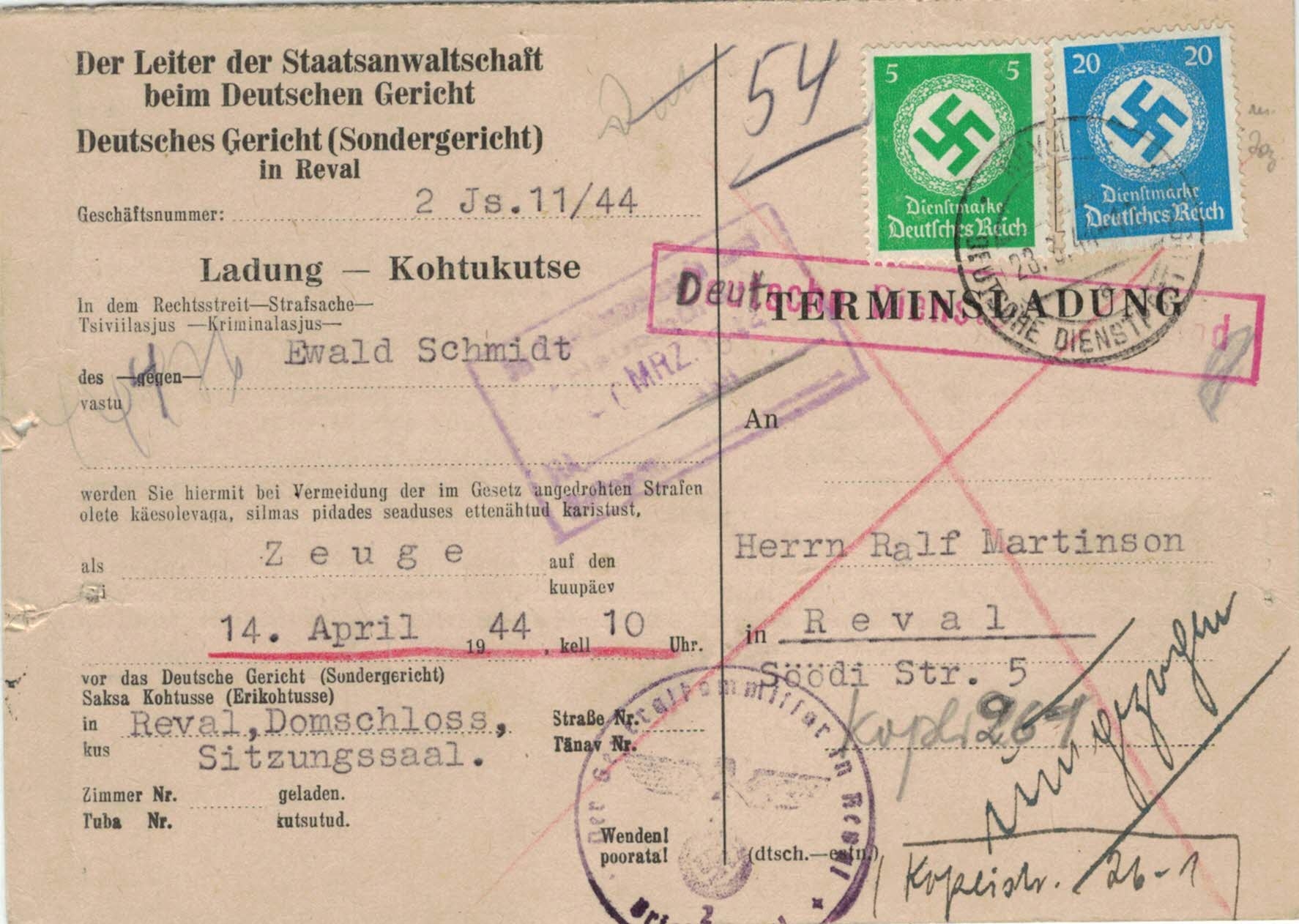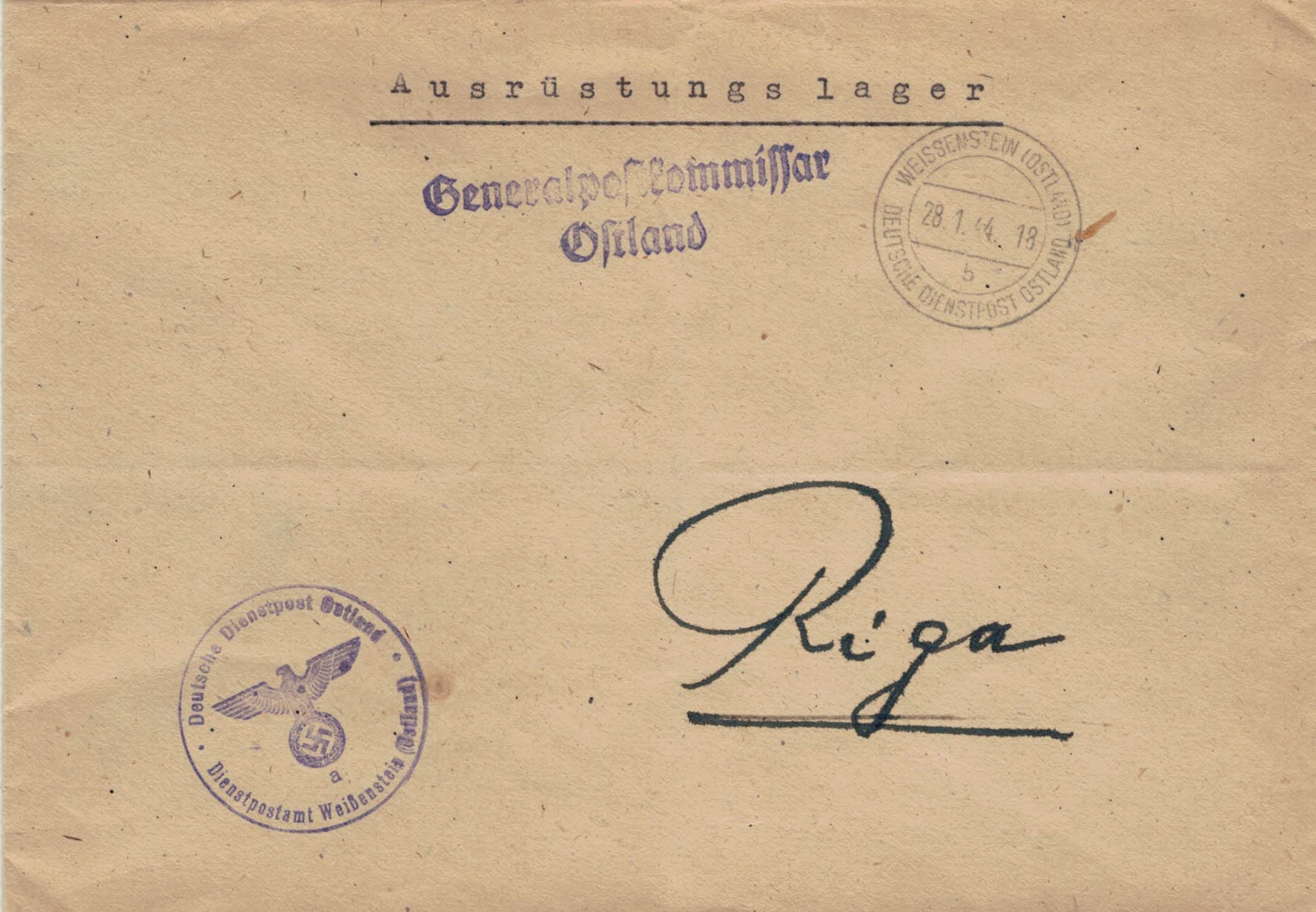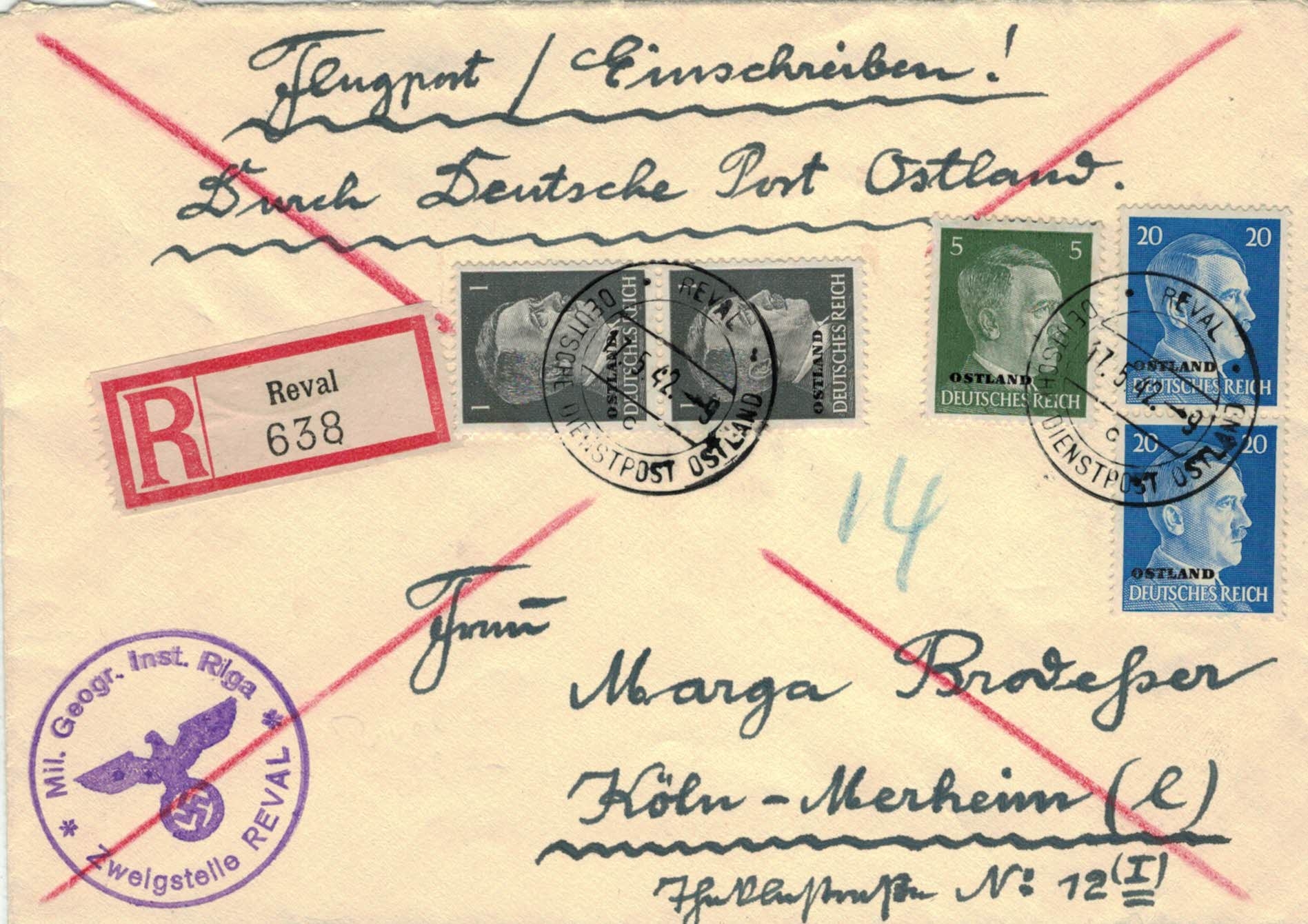Estonia
-
Royal Swedish Post
-
Imperial Russian Post
-
German Occupation / Ob. Ost
-
Independent Republic of Estonia
-
Soviet occupation
-
German occupation / Ostland
The General Post Commissariat in the Reich Commissariat Ostland
With the German attack on the Soviet Union starting on June 22, 1941, the Reich Ministry for the Occupied Eastern Territories ordered the establishment of the Reichskommissariat Ostland with administrative headquarters in Riga on June 25, 1941. This was divided into the four general districts of Estonia, Latvia, Lithuania and White Ruthenia with administrative headquarters in the respective capitals.
At the same time, the Generalpostkommissariat Ostland was established with administrative headquarters in Riga and analogous administrative structures. The Reichspostministerium and with it the "Deutsche Post im Ostland" as an organ of the Deutsche Reichspost had the technical responsibility for all postal matters.
The resulting tense dual structures between the ideologically influenced Reich Ministry for the Occupied Eastern Territories and the professionally influenced Reich Ministry of Posts led to a continuous struggle for competence within the German occupying power and to sometimes considerable freedom to favour professional regulations, especially for the Latvian and Estonian postal administrations.
Parallel to the advance of German military units from south to north, civilian post offices opened their counters in Lithuania, Latvia and Estonia from July 1941 to serve the local population. These offices basically attempted to restore the postal conditions from the period of political independence 1918-1940. The many local issues and, at the national level, the national postal issues owe their existence to them.
Both, local editions as well as editions of the regional posts, belong temporally and formally legally to the editions during the Reichskommissariat Ostland, but not to the editions of the Reichskommissariat Ostland. They will therefore only be discussed briefly and as examples in the following.

Outline map of the Ostland
For detailed maps, e.g. postal routing maps of the General Districts, see Historic Maps on this web.
Until the Reichskommissariat Ostland issued its own stamps from November 4, 1941, all German postage stamps were initially valid for postage. These were also tolerated afterwards, but the Post Offices of the German Service Post Ostland sold only stamps of the German Reich with the ""Hitler Head"" design and the overprint ""Ostland"". This also applied to the Baltic Civilian Post Offices, but initially with the exception of Estonia, where the local issues of Dorpat (Tartu), which had been declared national postal issues, remained available at the counter until November 30, 1941 and remained valid for postage at a ratio of 1:10 (1 ruble equals 10 pfennigs) until April 30, 1942.
The Soviet postage rates that had been in force since December 1940/early 1941 continued to be valid for the area of the national post offices. With the gradual takeover of all post offices in the Baltic States, including civilian ones, by the Deutsche Dienstpost Ostland and subsequently by the Deutsche Post im Ostland, their domestic rates applied, while the reduced rates for local traffic did only apply from July 1, 1943. From January 1944, the entire area of the General Post Commissariat Ostland received the uniform postcode (area code) "5c".
With the extensive evacuation of the Baltic States from German forces from July 1944 onwards, the area of responsibility of the General Postkommissar Ostland was visibly reduced. Riga was evacuated on October 14, 1944. As early as September, the postmaster general's office had been moved to Libau (Liepāja), the administration to Köslin in Hinterpommern, and in early 1945 to Chemnitz, Frankfurt/Oder and Artern. From Köslin, collectors' postmark requests were still fulfilled until January 1945 using the Mitau postmark of the Deutsche Dienstpost Ostland.
On January 25, 1945, the Reichskommissariat Ostland was formally liquidated. At the time of the total German surrender on May 8, 1945, the former territory of the General Post Commissariat Ostland was limited in real terms to the German service post offices in Libau (Liepāja), Windau (Ventspils), Goldingen (KuldĪga) and Talsen (Talsi) as well as the offices of the Latvian national post in this area. Some of these offices operated until they were occupied by Soviet troops at the end of May 1945.
The overprint issue of the same name (Kurland), Michel Nos. 1 to 4, produced from stamp stocks of the Army Group Kurland, Field Post Office Libau, was officially supposed to be issued at the remaining post offices on April 20, 1945, Adolf Hitler's 56th birthday. Whether the stamps were actually issued, and if so, to what extent, remains unclear. As of today, no postal items used-on-demand are known to exist.
With the reoccupation by Soviet troops and (re)incorporation into the Soviet Union, their postal rates and regulations were generally applied again.
Timetable Reich Commissariat Ostland
Year Date Event 1941 22.06. German attack on the Soviet Union 25.06. Foundation of the General Post Commissariat Ostland in the Reich Commissariat Ostland from July
(partly until spring 1942)Opening of offices of the Deutsche Dienstpost Ostland (DDO) and the Deutsche Feldpost (not discussed here) for German service personnel and third parties entitled to use them.
Opening of civilian post offices in Lithuania, Latvia and Estonia to serve the local population (initially only domestic mail)
Issuance of national postal stamps, in Estonia and Lithuania also numerous local issues
until 3.11. Exclusive use of German postage stamps without "Ostland" overprint by DDO from 4.11. Issue of permanent postage stamps (PWZ) in the drawing Hitler's head with the overprint OSTLAND for all post offices in the Ostland (DDO, Feldpost, Landespost).
Continued use of permanent stamps without overprint and toleration of special postage stamps
1.12. All civilian (state) post offices in the general districts are placed under the control of the Deutsche Dienstpost Ostland (DDO).
German domestic fees apply
1943 from 1.7. Reduction of charges in local traffic for postcards and letters from 6 and 12 pfennigs to 5 and 8 pfennigs 1944 from January Uniform postal code (area code) "5c" for the whole of the Ostland 24.06. Fall of Vilnius and Kaunas
Extensive evacuation of the General District of Lithuania (until July 13)
from August Extensive evacuation of the General Districts of Estonia (by September) and Latvia (by October) from September Transfer of the postmaster general's office to Libau (Liepāja) and the administration to Köslin in Hinterpommern 22.9. Withdrawal from Reval (Tallinn) 14.10. Withdrawal from Riga 1945 24.1. Formal dissolution of the Reich Commissariat Ostland 3.3. Fall of Köslin
As early as the beginning of 1945, remaining parts of the administration were transferred to Frankfurt/Oder, Chemnitz and Artern.
Closure of the collector service
20.4. Overprint issue KURLAND on stamp stocks of the Army Group Kurland, Field Post Office Libau 8.5. Germany's unconditional surrender Until end of May The offices of the Deutsche Dienstpost Ostland in Kurland, i.e. Libau (Liepāja), Windau (Ventspils), Goldingen (KuldĪga) and Talsen (Talsi), as well as the offices of the Latvian Land Post continue to work partly under their own responsibility until the Soviet occupation. Special literature is recommended:
Estonia before and as part of the "Generalpostkommissariat OSTLAND"). Harry von Hofmann Verlag, Hamburg 2010. 472 pp. ISBN 978-3-7636-5079-8.
Latvia before and as part of the "Generalpostkommissariat OSTLAND"). Harry von Hofmann Verlag, Hamburg 2001. 448 pp. ISBN 3 7636 5074 1.
Wilhelm van Loo: Postal traffic Kurland (Courland) (1944-1945). Publication series of the Bund Philatelistischer Prüfer e.V., Volume 7, Aachen 2016. 312 pp. without ISBN
Reich Commissariat Ostland, Crime scene and object of remembrance. Published in: Age of the World Wars. Ed. Military History Research Office, Vol. 8. Ferdinand Schöningh 2012. 371 pp. ISBN 978-3-506-77188-9.
Science Planning Displacement, The General Plan East of the National Socialists. Catalogue for the exhibition of the German Research Foundation. DFG 2006. 36 pp.
General District Estonia
On August 29, 1941, the last Soviet troops evacuated the Estonian capital Tallinn (Reval), whereupon on 3 September the German Wehrmacht commander for the rear army area north granted the Estonian postal administration permission to resume civilian letter traffic within Estonia. On September 29, 1941, the latter declared all local issues issued until then (again) to be invalid:
Nüggen (Nõo), Mid-July 1941 (without illus.)
Wesenberg (Rakvere), August 7, 1941 (without illus.)
Moiseküll (Mõisaküla), August 4, 1941
The two series issued in Dorpat (Tartu) were exempt from the invalidation, i.e. continued to be valid:
Coat of arms issue, Michel Nr. 1–3, August 7/12, 1941
Also on September 29, 1941, the Estonian postal administration partially suspended the Soviet postal fees valid until then and doubled the domestic fees for the most common types of mailing of the printed matter to 30 kopecks, the postcard to 40 kopecks and the letter to 60 kopecks. These fees remained nominally in force until November 30, but were not enforced nationwide until then.
With the arrival of the postal commissioner Eisenmann in Tallinn (Reval) on October 25, responsibility on the German side changed from the military to the civilian side of the occupying power. The latter subordinated all Estonian post offices to itself as part of the Deutsche Dienstpost Ostland (DDO). At the same time in all general districts, the regulation also came into force in Estonia on December 1, 1941. From this date onwards, only definitive stamps of the German Reich in the design of Hitler's head with the overprint "Ostland" were sold at all post offices. The domestic rates of the German Reich came into effect.
On 1 December 1941, however, only two post offices of the DDO began their activities: Reval (Tallinn) and Pernau (Pärnu). All other German service post offices followed, some much later: Arensburg (Kuressaare), Dorpat (Tartu), Fellin (Viljandi), Hapsal (Haapsalu), Narwa (Narva), Petschur (Petseri), Taps (Tapa), Walk (Valga), Weißenstein (Paide), Werro (Võru) and Wesenberg (Rakvere).
It was not before the " German Post Office in the Ostland" took up its duties on April 24, 1942 that the responsibility for the mail of Estonian as well as German civilians and the DDO was combined under one roof.
On January 15, 1942, postal traffic between Estonia, Latvia and Lithuania was resumed on a limited basis, and on February 1, 1942, with the German Reich, including the territories they had de facto annexed.
The parcel service was resumed on April 15, 1942, and the domestic rates for the local service (postcard and letter) were reduced from 6 and 12 pfennigs to 5 and 8 pfennigs respectively on July 1, 1943. Postal payment transactions and the parcel service were subject to separate regulations.
There are no written regulations for the postal traffic of Estonian civilians with the states occupied by the German Reich, with its allies and with neutral states. The number of mail items transported without a complaint suggests that they were handled in the same way as the regulations for the German Reich.
With the re-occupation of Reval (Tallinn) on September 22, 1944 and Pernau (Pärnu) the following day, the Ostland period in the Estonian General District came to an end.
Timetable General District Estonia
Ostland Estonia June 22, 1941
German attack on the Soviet UnionJune 25, 1941
Foundation of the General Postal Commissariat Ostland in the Reichskommissariat OstlandFrom July 1941
Issuance of numerous local issues, at the national level national postal issues (in ruble currency)July 10 Elwa (Elva) Mid-July Nüggen (Nõo) July 22 Odenpäh (Otepää) August 4 Moiseküll (Mõisaküla) August 7 Wesenberg (Rakvere) August 7/12 Dorpat (Tartu) Coat of arms issue, Mi Nos. 1-3 August 16 Pernau (Pärnu) September 22 Dorpat (Tartu) Reconstruction issue, Mi Nos. 4-9 August 29, 1941
Soviet Army clears Reval (Tallinn)September 3, 1941
Resumption of civilian letter traffic within Estonia by the national post office.September 29, 1941
(Renewed) suspension of the local issues of Elwa, Nüggen, Odenpäh, Moiseküll, Wesenberg and Pernau by the Estonian National Post Office.
The coat of arms issue and the reconstruction issue, both issued in Dorpat (Tartu), remain valid nationwide until April 30, 1942.September 29 – November 30, 1941
Doubling of domestic rates for printed matter to 30 kopecks, postcards to 40 kopecks and letters to 60 kopecks.by November 3, 1941
all German postage stamps valid for frankingFrom November 4, 1941
– Issuance of own stamps for the Reichskommissariat Ostland (in Reichsmark and Pfennig)
– Toleration of the use of stamps of the German Reich without overprinting.>Until November 30, 1941
Closing down the sale of the Landespost issues in the civilian post officesDecember 1, 1941
– Change of jurisdiction from the military to the civilian side of the German occupying power, all civilian post offices become part of the Deutsche Dienstpost Ostland (DDO)
– From now on, German domestic rates
– Counter sales of German Reich stamps in the post offices of the Deutsche Dienstpost Ostland only with imprint "Ostland"The first two Deutsche Dienstpost Ostland (DDO) offices in Tallinn (Reval) and Pärnu (Pernau) open their counters. Other service post offices (Arensburg, Dorpat, Fellin, Hapsal, Narwa, Petschur, Taps, Walk, Weißenstein, Werro, Wesenberg) follow later. January 15, 1942
Resumption of postal traffic between Estonia and the General Districts of Latvia and LithuaniaFebruary 1, 1942
Re-establishment of postal traffic with the German Reich including the territories de facto annexed by themApril 15, 1942
Re-launch of the Parcel ServiceApril 24, 1942
Summarising the responsibility for the mail of Estonian as well as German civilians and the DDO under the umbrella of the "German Post in the Ostland“From July 1, 1943
reduced charges for local traffic for postcard and letter from 6 and 12 Pfennig to 5 resp. 8 PfennigFrom January 1944
uniform postal code (area code) "5c" for the entire OstlandFrom June 1944
Clearance of the Baltic from German forcesSeptember 22, 1944
Re-occupation of Tallinn by Soviet forcesSeptember 23, 1944
Re-occupation of Pärnu by Soviet forces
End of the Ostland period in the Estonia General District -
Camp Mail / Estonians in Exile
-
Independent Republic of Estonia (restored)
-
Private Mail in Estonia


